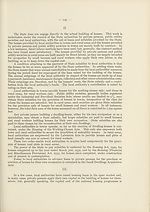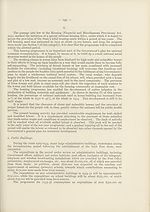Download files
Complete book:
Individual page:
Thumbnail gallery: Grid view | List view

— 148 —
provided by the State out of the lyocal Loans Fund. State loans are made direct to local
authorities for building schemes. Loans to private persons providing houses for their
own occupation are made by the State through the intermediary of the local authorities.
State loans for housing are repayable within a period of thirty-five years by an annuity
to cover principal and interest.
Under the Housing Act, 1929, State subsidies took the form of cash grants ranging
from £45 to £60. Under the Housing (Financial and Miscellaneous Provisions) Act, 1932,
which applies to houses completed since April 1st, 1932, State subsidies are subject to the
following maxima :
(a) To local authorities providing houses in towns to replace unhealthy houses : 66§ % of the
annual loan charges.
(b) To local authorities providing houses in towns for persons other than those displaced
from unhealthy houses : 33!% of the annual loan charges.
(c) To local authorities providing houses in rural areas : 60% of the annual loan charges.
(d) To public utility societies providing houses in towns for letting at rents approved of
by the State authorities : a cash grant of £100 per house provided the local authority concerned
agrees to give a supplemental cash grant of £50.
(e) To private persons and public utility societies providing houses in urban areas without
restriction as to sale or letting : a cash grant of £50.
(f) To small farmers providing houses in rural areas for their own occupation : a cash grant
of £60 or £70, depending on value of farm.
(g) To rural workers providing houses for their own occupation : a cash grant of £70.
(h) To public utility societies providing houses in rural areas for small farmers : a cash
grant of £70 or £80, depending on value of farm.
(i) To public utility societies providing houses in rural areas for rural workers : £80.
(j) To private persons in rural areas other than small farmers and agricultural labourers :
£45-
(k) To small farmers and rural workers for the reconstruction of their own houses : £40.
In addition, two-thirds of the rates are remitted for a period of seven years on the
houses in categories (e) to (j) inclusive, while in the case of reconstructed houses, the
valuation on which rates are assessed is not increased, as a result of the reconstruction,
for a period of seven years. Rates reliefs are not given in respect of houses in categories
(a) to (d), the local authorities being required to contribute to these houses in the form
of an annual loss in letting in the case oi (a), (b) and (c), and in the form of a supplemental
cash grant in the case of (d).
Loans under the Small Dwellings Acquisition Acts to persons purchasing or erecting
houses for their own occupation are limited to 90% of the market value of the houses,
and the market value must not exceed £1,000 per dwelling.
Loans to local authorities are secured on the local rates; loans to private persons are
secured by mortgage on the house in respect of which the loan is issued.
The annual expenditure of the State in subsidies is charged to the ordinary budget
of the State.
IV.
The cost of the average working-class house in a town is divided generally about
45% materials and 55% labour. In rural areas, the percentage cost of materials
increases, even for contract work (labour being cheaper); but in the case of most of the
houses being built or reconstructed by small farmers and rural workers, the bulk of the
cost is for materials, as the persons building or reconstructing the houses apply their own
labour to the work.
For houses completed up to the year ended March 31st, 1932, national materials
represented about 30 % of the total value of materials used. Since then, the percentage
of national materials has increased to about 45%.
provided by the State out of the lyocal Loans Fund. State loans are made direct to local
authorities for building schemes. Loans to private persons providing houses for their
own occupation are made by the State through the intermediary of the local authorities.
State loans for housing are repayable within a period of thirty-five years by an annuity
to cover principal and interest.
Under the Housing Act, 1929, State subsidies took the form of cash grants ranging
from £45 to £60. Under the Housing (Financial and Miscellaneous Provisions) Act, 1932,
which applies to houses completed since April 1st, 1932, State subsidies are subject to the
following maxima :
(a) To local authorities providing houses in towns to replace unhealthy houses : 66§ % of the
annual loan charges.
(b) To local authorities providing houses in towns for persons other than those displaced
from unhealthy houses : 33!% of the annual loan charges.
(c) To local authorities providing houses in rural areas : 60% of the annual loan charges.
(d) To public utility societies providing houses in towns for letting at rents approved of
by the State authorities : a cash grant of £100 per house provided the local authority concerned
agrees to give a supplemental cash grant of £50.
(e) To private persons and public utility societies providing houses in urban areas without
restriction as to sale or letting : a cash grant of £50.
(f) To small farmers providing houses in rural areas for their own occupation : a cash grant
of £60 or £70, depending on value of farm.
(g) To rural workers providing houses for their own occupation : a cash grant of £70.
(h) To public utility societies providing houses in rural areas for small farmers : a cash
grant of £70 or £80, depending on value of farm.
(i) To public utility societies providing houses in rural areas for rural workers : £80.
(j) To private persons in rural areas other than small farmers and agricultural labourers :
£45-
(k) To small farmers and rural workers for the reconstruction of their own houses : £40.
In addition, two-thirds of the rates are remitted for a period of seven years on the
houses in categories (e) to (j) inclusive, while in the case of reconstructed houses, the
valuation on which rates are assessed is not increased, as a result of the reconstruction,
for a period of seven years. Rates reliefs are not given in respect of houses in categories
(a) to (d), the local authorities being required to contribute to these houses in the form
of an annual loss in letting in the case oi (a), (b) and (c), and in the form of a supplemental
cash grant in the case of (d).
Loans under the Small Dwellings Acquisition Acts to persons purchasing or erecting
houses for their own occupation are limited to 90% of the market value of the houses,
and the market value must not exceed £1,000 per dwelling.
Loans to local authorities are secured on the local rates; loans to private persons are
secured by mortgage on the house in respect of which the loan is issued.
The annual expenditure of the State in subsidies is charged to the ordinary budget
of the State.
IV.
The cost of the average working-class house in a town is divided generally about
45% materials and 55% labour. In rural areas, the percentage cost of materials
increases, even for contract work (labour being cheaper); but in the case of most of the
houses being built or reconstructed by small farmers and rural workers, the bulk of the
cost is for materials, as the persons building or reconstructing the houses apply their own
labour to the work.
For houses completed up to the year ended March 31st, 1932, national materials
represented about 30 % of the total value of materials used. Since then, the percentage
of national materials has increased to about 45%.
Set display mode to:
![]() Universal Viewer |
Universal Viewer | ![]() Mirador |
Large image | Transcription
Mirador |
Large image | Transcription
Images and transcriptions on this page, including medium image downloads, may be used under the Creative Commons Attribution 4.0 International Licence unless otherwise stated. ![]()
| League of Nations > Communications and transit > Enquiry on national public works > (150) |
|---|
| Permanent URL | https://digital.nls.uk/195000300 |
|---|
| Shelfmark | LN.VIII |
|---|
| Description | Over 1,200 documents from the non-political organs of the League of Nations that dealt with health, disarmament, economic and financial matters for the duration of the League (1919-1945). Also online are statistical bulletins, essential facts, and an overview of the League by the first Secretary General, Sir Eric Drummond. These items are part of the Official Publications collection at the National Library of Scotland. |
|---|---|
| Additional NLS resources: |
|

